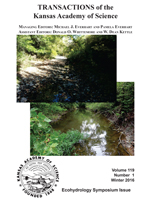Meteorological drought in the Great Plains of the U.S. has a significant influence on the hydrology of small drainage basins. Its effect on local surface water and groundwater systems is complicated when streamflow is regulated by flood-control reservoirs. An analysis of local precipitation, discharge, and groundwater records on annual, monthly, and daily intervals in the upper Neosho River of Kansas demonstrates the importance of frequent, small-scale monitoring to resource management. Natural, drought-induced, noflow conditions prior to reservoir construction were eliminated by sustained, low-volume, reservoir outflow over five drought cycles. Temporary bank storage, caused by reservoirinduced, high-flow pulses, was observed at the Emporia State University Campus Woods field station during a prolonged recent drought. Gaining and losing stream conditions were observed in multi-year monitoring but, in drought years, losing conditions occurred only when reservoir releases generated stream flow. In drought and non-drought years, relatively low groundwater levels coincided with seasonal growing periods, reflecting the importance of transpiration by riparian vegetation on stream-aquifer exchange. An understanding of the drought response of the individual elements of a floodplain hydrologic system is important to management of the integrated resource.
How to translate text using browser tools
1 January 2016
The Impact of Drought on Streamflow and Stream-Aquifer Exchange in the Upper Neosho River, Kansas
Marcia K. Schulmeister,
D. Marie Barlow
ACCESS THE FULL ARTICLE





